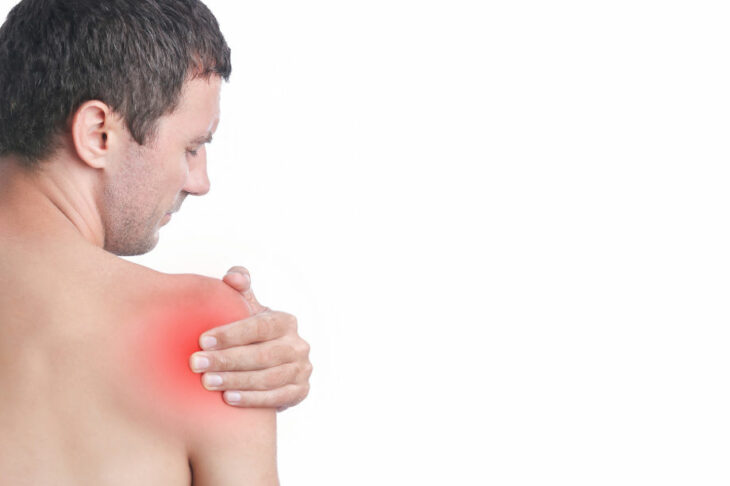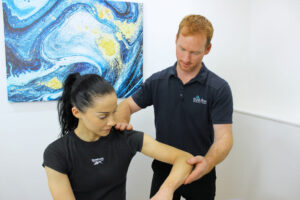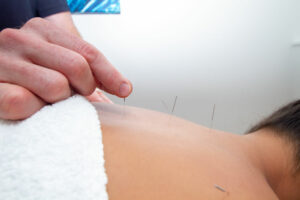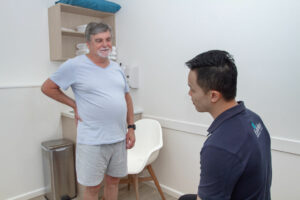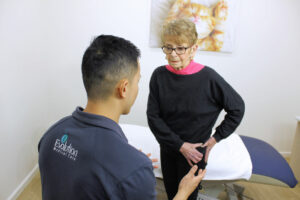Shoulder pain is extremely common throughout Australia and as many as 70 percent of us will experience some form of shoulder pain in our lifetime. There are many possibilities as to what could be causing your shoulder pain, one of which is Shoulder Bursitis!
Our shoulders are one of the most mobile joints in the body, which allow for bending, lifting, and rotating of the arms to perform many different day-to-day tasks. The shoulder muscles and tendons work simultaneously to create movement, while bursas (small fluid-filled sacs) reduce friction within the joint as well as in and around the tendons also.
However, when the shoulders become overloaded or overworked, these bursas become swollen and inflamed, which leads to the condition known as Shoulder Bursitis.
For sufferers of Shoulder Bursitis, the pain can range from an infrequent nag to ongoing, debilitating pain. I’m talking about pain that makes it difficult when trying to use your arms to attend to daily activities like walking the dog or driving.
What’s worse, for most people with Shoulder Bursitis, pain is just the beginning of the issue. It extends to decreased range of motion of the shoulder which leads to an inability to carry out recreational activities including things like swimming or tennis. For so many sufferers it even means that they must take time off work or reduce working hours. All in all, it’s safe to say Shoulder Bursitis has a huge impact on quality of life – which is frustrating, to say the least!
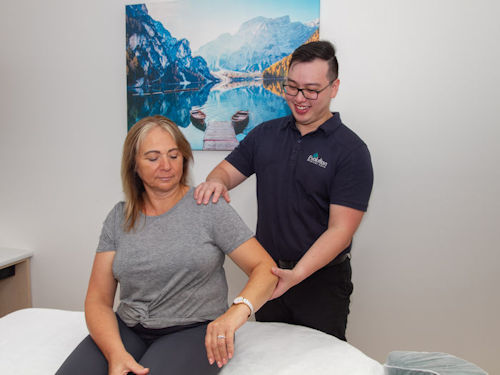
So many patients that I work with suffering from Shoulder Bursitis also have issues with sleeping because of the ongoing pain and discomfort…
I’m sure you get the gist by now, Shoulder Bursitis is far from ideal and if you’ve been suffering from this condition, then I’m sure that you have had enough of it!
Now, there is a load of treatment options out there when it comes to Shoulder Bursitis and the issue of course is that some are more suited to different situations than others. Treatment options vary and may include medications, manual therapies, and even surgical interventions.
The good news is that for individuals suffering from this condition, there are many options to help improve symptoms, which are beneficial not only in the short term but the long term also. This will mean that you will be able to get back to your full physical and mental capabilities like you once were – so long as you take the right steps!
Keep reading to check out my 8 Tips to Resolve Shoulder Bursitis.
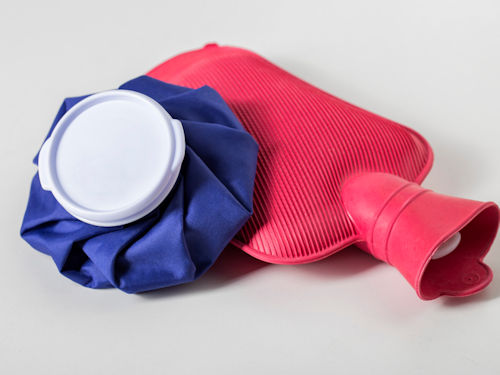
1. Rest
When bursitis is in the acute phase, resting the shoulder is imperative!
Rest has an impact to reduce the inflammation that was directly related to the activity which caused the issue to occur. By restricting the movement of the shoulder, you are no longer aggravating the already inflamed bursa, and inflammation will begin to subside. On occasion, putting the arm in a sling to fully immobilize the area may be needed in extreme situations.
Symptoms of Shoulder Bursitis can last from a few days to many months in duration and in every case, this amount of time can be reduced by implementing rest.
2. Ice and Heat Therapy
Ice is highly beneficial for inflammatory conditions, especially in the acute phase of bursitis, due to its ability to settle inflammation and associated pain. For best results, follow my comprehensive icing protocol:
- Apply ice directly to the impacted area – This can be done with something simple like a bag of frozen peas. Be sure to wrap it in a tea towel to avoid burning the skin.
- Leave on the area for 15-20 minutes – This should not cause further pain, nor inflame the skin.
- Repeat throughout the day for a minimum of four times.
After the icing phase for the first 24 hours, it is ideal to then begin warming the area. This can be done via the use of heat packs or a hot shower or bath.
- Apply a heat pack on the impacted area or take a warm shower each morning and night (ensuring the water can be focused on the impacted area) – duration 10-15 minutes.
- Continue this for 5 consecutive days
3. Intervention With Medication
In the majority of cases, medications can assist in relieving inflammation and pain. Medications are generally fast-acting and should be used to relieve pain temporarily.
Medications although helpful, offer only short-lived relief. The effects will not last long and may lead to even further complications. When the pain is numbed, it means you may cause further damage to the area because you are now able to use the shoulder more uninhibited by pain, and therefore once the medication stops working, the condition and pain may be far greater than previously.
Non-Steroidal Anit-Inflammatory Drug (NSAIDs)
Ibuprofen is the most highly sort after medication for individuals who are suffering from Shoulder Bursitis, due to being available over the counter without the need for a prescription. This is also a non-steroidal anti-inflammatory drug (NSAIDs). Medications, such as NSAIDs, aid with both localised inflammation and pain. These should be always taken as directed.
Other forms of NSAIDs include:
- Aspirin – Aids with swelling and pain
- Ibuprofen – Aids with pain
- Naproxen – Aids with pain
- Acetaminophen (Tylenol) – Aids with pain
If you do not take medication as directed such as taking a higher dosage or for a longer period of time than prescribed. This can cause potentially dangerous side effects.
Potential side effects can include heart, kidney, and gastrointestinal problems. This happens with taking NSAIDs daily for a long duration.
Corticosteroid Injections
For severe incidences of Shoulder Bursitis, a corticosteroid injection may be used to relieve inflammation and pain, though should not be the first form of treatment, and only opted for when other measures have failed to achieve a positive outcome.
For individuals who experience chronic and severe pain, corticosteroid injections may be used to manage pain whilst still undergoing other forms of treatment like Acupuncture.
Corticosteroid injections work by decreasing inflammation in the local area. However, there are notable side effects with the injection which may even weaken surrounding tendons and muscles. AGAIN, due to potential side effects, this injection should be used sparingly and only if physical therapy, medication, and rest fail to relieve symptoms.
4. Stretches
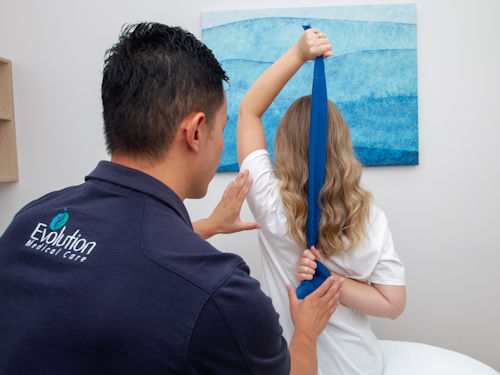
The bursa sack itself cannot be stretched or exercised, however, what individuals can do is stretch the surrounding tendons and muscles to decrease pressure applied to the bursa and reduce inflammation.
Once pain and inflammation have begun to subside, Shoulder Bursitis stretches can aid in increasing shoulder range of motion, thus creating better shoulder health. Low-impact stretches can and should be performed
each day.
It is important to note, shoulder exercises and stretches should be performed on both shoulders, not just the impacted shoulder.
My top shoulder exercises used to stretch and strengthen the shoulder are:
Shoulder Blade Squeeze
- Stand with feet shoulder-width apart, and with your arms by your side
- Keep shoulders relaxed and in a position that is comfortable
- Focus on bringing shoulder blades together, by moving your arms backward. Hold these positions for 15 seconds before returning the shoulder blades to their normal position. Repeat 3 times.
Wall Push-Ups
- Stand facing any wall throughout your home
- Position your feet shoulder-width apart and slightly away from the wall
- Learn into the wall with hands shoulder-width apart, just below your shoulder height
- Bring your torso toward the wall, followed by pushing off the wall, and then repeat this movement Repeat 10 times. Rest 30 seconds and repeat for another 10 push-ups.
Overhead Stretch
- Stand shoulder width apart, chest out and shoulder back
- Raise either your Left or Right arm above the head, bend through the elbow joint, followed by placing your hand behind the neck
- With the opposite hand, hold the elbow and slowly/gently push backwards
- Hold the stretch for 30 seconds, before swapping to the opposite arm.
Shoulder Circles
- Stand with feet shoulder-width apart
- Lift both shoulders toward the ears, followed by pausing at the top
- Begin to circle the shoulder down and back, feeling the shoulder blades coming together in the middle of the back as you lower them
- Repeat 10-15 times.
5. Strapping
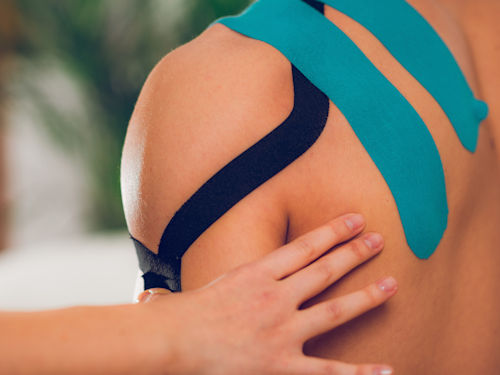
Strapping is typically used for the following instances:
- After a shoulder injury has occurred.
- Strapping the area may help prevent shoulder dislocations or AC joint sprains – AC refers to the Acromioclavicular which connects the clavicle (collar bone) to the scapula (shoulder blade). This helps in numerous ways, but notably rib cage stability and helps with shoulder flexion and abduction (moving the arm away from the body in a sideways motion)
- To prevent injury from occurring or aggravating an existing injury.
- During high-impact sports, to prevent further problems with the impacted area
Weaning off from shoulder taping should involve general activities to aid with range of motion, strength, function, and reducing symptoms.
6. Acupuncture
Acupuncture is performed by using needles in locations around the body that have a localised anti-inflammatory response. This is done in conjunction with trigger points (points of soreness upon touch) to relieve pain, increase range of motion, and increase strength.
With relation to Shoulder Bursitis, Acupuncture can relieve overall muscle tension, which is causing the humeral head (upper arm bone) to shift in a forward position and aggravate bursitis.
During an Acupuncture treatment, the small needles are gently inserted in specific locations to assist with reduction in muscle stiffness and promote overall blood flow to aid in muscle recovery.
Acupuncture can also be used in other areas of the body, which directly relate to the area of concern, but are not localised at the site. Treatment through these channels will help with the body’s stress and pain response, having powerful relieving properties. Herbal medication may also be used to help further reduce inflammation and pain and speed up recovery times.
7. Surgical Interventions
When all other methods have been explored with minimal outcomes, and for extreme/chronic Shoulder Bursitis which does not resolve after 9 months of treatment, surgical interventions to drain or remove the bursa can be looked at as a solution. Surgery may be recommended when the bursitis is causing relevant pain and/or shoulder impingement.
8. Seek Care From an Experienced Professional
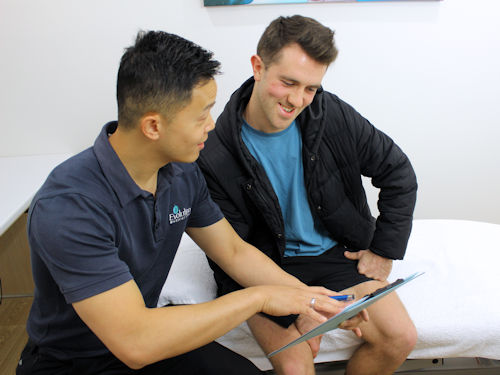
If you want to learn more about resolving your Shoulder Bursitis, the best way is to seek to advice from a healthcare professional, that is experienced in working with this condition.
When working with Shoulder Bursitis we diagnose the direct cause of the pain, whilst addressing any underlying issues that have caused bursitis initially. We will be able to set out an appropriate course of treatment that will get you back on track ASAP!
Treatment plans may consist of treatment therapies such as:
- Acupuncture
- Electro-Acupuncture
- Manual Therapy techniques such as Remedial Massage, Trigger Point Therapy or Cupping Therapy
- Trans-Cutaneous Electrical Nerve Stimulation (TENS) Therapy
- Auriculotherapy
- Postural Manipulation Therapy
- Exercise Prescription
- Herbal or Mineral Supplement Prescription
- Lifestyle Advice
These are just part of what our team will provide. Starting a treatment plan with us is a means to achieve faster pain relief and longer-lasting results.
Have You Had Enough of Shoulder Bursitis?
Shoulder Bursitis is an extremely debilitating and painful inflammatory condition that can range in pain severity and duration. The best way to handle Shoulder Bursitis is to act NOW and put into practice my 8 tips, to avoid further impact and disruption to your quality of life. Acupuncture and other treatments that we can provide are a non-invasive method of achieving fast and effective pain relief for people suffering from this condition.
If you’re ready to take control of your health, make the change today and give our team a call (02) 4709 6727 to see how we can help.

